
Toyota’s 70 Series dates back more than 30 years, and this latest round of significant updates is the first in four years. Many are a result of mandatory emissions compliance and industry safety demands.
All variants get a new five-speed manual gearbox that brings a much-welcome taller top gear as well as a taller second gear. All models also get auto-locking hubs, cruise control, and electronic stability and traction control. Single Cab models then get additional curtain and driver’s knee airbags and thicker frame rails, among other changes, which results in five-star ANCAP safety compliance. Euro 5 emissions compliance changes for the 4.5-litre V8 diesel run to piezo injectors and a diesel particulate filter, which combine with the new gearbox to lower the fuel use by around 10 per cent – not an insignificant result.
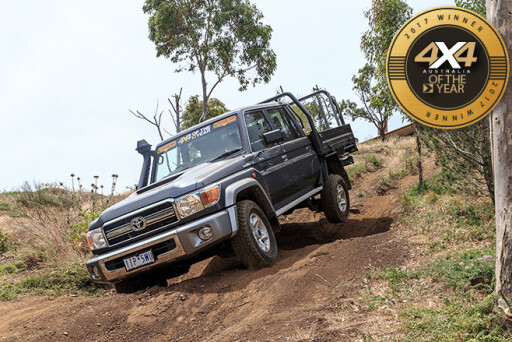 For 4X4OTY we tested the Toyota LandCruiser 79 GXL Double Cab. The cheaper WorkMate has 16-inch one-piece steel wheels and vinyl seats, while the lockers become a $1500 option. Toyota offers five genuine-accessory trays for the Double Cab with either headboard or under-tray mounted spare wheels. Prices range from $2325 for a basic alloy tray with headboard spare to $6088 for the heavy duty tray with under-mount spare.
For 4X4OTY we tested the Toyota LandCruiser 79 GXL Double Cab. The cheaper WorkMate has 16-inch one-piece steel wheels and vinyl seats, while the lockers become a $1500 option. Toyota offers five genuine-accessory trays for the Double Cab with either headboard or under-tray mounted spare wheels. Prices range from $2325 for a basic alloy tray with headboard spare to $6088 for the heavy duty tray with under-mount spare.
TOURING
Of all the upgrades to the 70 Series Land Cruiser, the one that most benefits its touring capability is the (almost 15 per cent) taller fifth gear. Not only does the new gearing improve fuel economy, it makes the Land Cruiser more relaxed on the open road, with a shade under 2000rpm showing on the tacho at 100km/h in top gear.
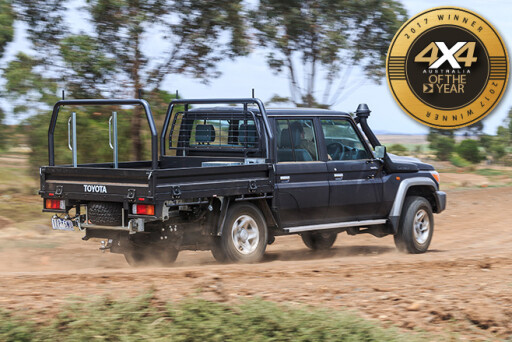
The Land Cruiser feels very predictable on the open road, although the recirculating ball and nut steering will feel a bit vague to those used to modern rack-and-pinion set-ups. As you’d expect from a vehicle with a relatively tall ride height (and slightly narrower rear track), body roll is pronounced when cornering at speed, but it never feels untoward. Ride quality is more than acceptable over poor road surfaces, even when there’s minimal load in the tray, and road noise insulation is sufficient.
With a flat, upright windscreen, wind noise is pronounced and induction noise from the snorkel is ever present. However, push your foot into the go-pedal and the deep note of the TDV8 will soon override any other audible anomalies; it’s simply intoxicating.
See all of the action from 2017 4x4 of the Year
Another touring benefit is the new auto-locking hub set-up. You no longer have to exit the vehicle to lock the hubs if you want to engage 4WD on gravel after long stints on sealed roads. And if you’re going to be driving off-road for extended periods, you can manually lock the hubs using the vehicle’s wheel brace.
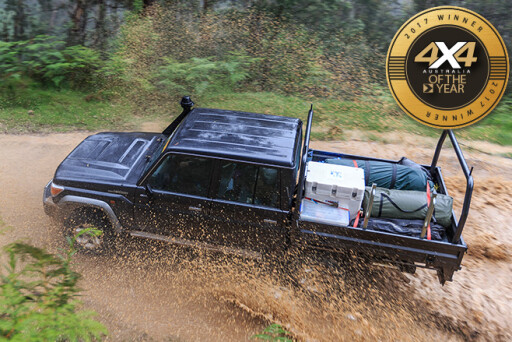
While it doesn’t benefit from all of the Single Cab’s upgrades, the addition of vehicle stability control to the 79 Double Cab is a great improvement, adding another level of safety without feeling too intrusive. Thankfully you can still slide the Cruiser around a bit before the electronic aid intervenes.
The addition of a diesel particulate filter to the LC79 has resulted in the removal of the 90L auxiliary fuel tank, so overall fuel capacity has been reduced from twin 90L tanks to a single 130L tank. With an average fuel consumption of 13.8L/100km on test, you can expect a safe touring range of just below 900km.
TRAIL DRIVING
The LC79 is one of the best out-of-the-box off-roaders on the market. Its 4.5L TDV8 develops oodles of low-rpm torque, and low-range gearing (44.1:1 in first gear) is excellent. Wheel travel is good front and rear and the Cruiser has plenty of ground clearance. A standard snorkel aids water crossings and the 265/70R16 tyres offer plenty of sidewall.
Second gear is now seven per cent taller, making it more flexible at low speeds, reducing the gap between second and third. And the hill-start assist function works well, making handbrake starts a thing of the past.
 The Cruiser easily conquered everything thrown at it off-road, and the only complaints on the trails were manoeuvrability in tight spots and the fact the lockers can take a while to actuate for tough conditions.
The Cruiser easily conquered everything thrown at it off-road, and the only complaints on the trails were manoeuvrability in tight spots and the fact the lockers can take a while to actuate for tough conditions.
SET-PIECE HILL CLIMB
With low-range selected and front and rear lockers engaged, the Land Cruiser 79 crawled up the set-piece hill climb with minimal fuss, just lifting a wheel here and there on the deepest holes in the track. However, with the lockers switched off and the electronic traction control on the Cruiser struggled but still made it a fair way up the hill climb.
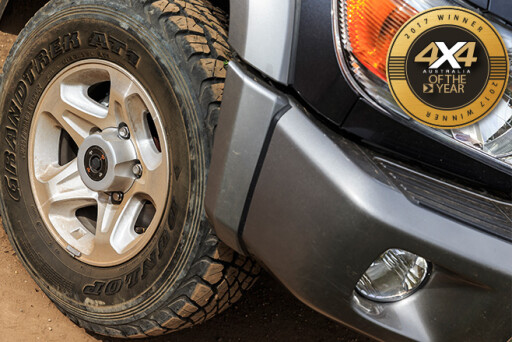 The Cruiser’s big TDV8 offers loads of low-rpm torque, and a decent overall low-range reduction of 44:1 in first gear makes crawling up steep hills easy. On the way back down, the Cruiser’s engine braking also proved exemplary.
The Cruiser’s big TDV8 offers loads of low-rpm torque, and a decent overall low-range reduction of 44:1 in first gear makes crawling up steep hills easy. On the way back down, the Cruiser’s engine braking also proved exemplary.
Despite being one of the more difficult vehicles to manoeuvre within the tight confines at the top of the hill (especially when the diff locks were being recalcitrant), the Cruiser still offers good visibility – over the bonnet and through the deep side windows. You have to love old-school, near vertical A-pillars! Ground clearance is good and the Cruiser didn’t bottom out anywhere on the set-piece hill climb.
CABIN, EQUIPMENT AND ACCOMMODATION
The LC79 now comes standard with ABS, vehicle stability control (VSC), active traction control (A-TRC), hill-start assist control (HAC), brake assist and electronic brake-force distribution. Other safety upgrades include front seatbelt pretensioners, but the SRS package in the Double Cab is limited to driver and passenger airbags. Cruise control is standard across the range but air-conditioning is not (it’s still a very hefty $2761 option).
 The LC79’s dash layout is basic but has everything you need, including comprehensive instrumentation, effective vents, a clock, and an easy-to-operate sound system. The driving position in the LC79 is a comfortable one, even if the seats are basic, and you’re afforded a good view over the bonnet. Rear-seat passengers are provided with a comfortable seat, but legroom and shoulder room could be better for such a big vehicle. The centre rear seat only has a lap belt, and there are no air-conditioning vents in the back.
The LC79’s dash layout is basic but has everything you need, including comprehensive instrumentation, effective vents, a clock, and an easy-to-operate sound system. The driving position in the LC79 is a comfortable one, even if the seats are basic, and you’re afforded a good view over the bonnet. Rear-seat passengers are provided with a comfortable seat, but legroom and shoulder room could be better for such a big vehicle. The centre rear seat only has a lap belt, and there are no air-conditioning vents in the back.
PRACTICALITIES
The LC79 comes standard with a snorkel and has a big, easy-to-access air filter. The alternator is located quite low in the engine bay where it’s susceptible to mud ingress in extreme conditions, and it’s not easy to get at. You could fit a second battery under the bonnet with a bit of fiddling.
The Cruiser’s 265/70R16 tyre size provides plenty of options for those who want to fit some tougher rubber. Everything under the LC79 is tucked up and out of harm’s way.
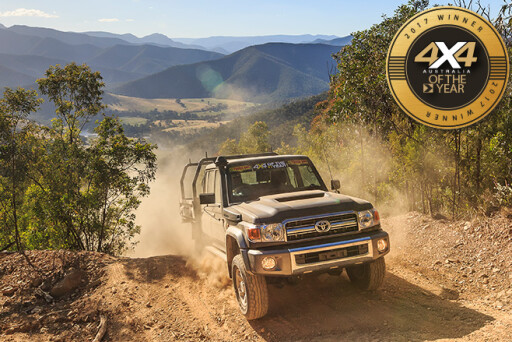 SUMMARY
SUMMARY
The Land Cruiser 79 has the heavy-duty 4x4 Double Cab market all to itself these days, and with its recent upgrades it’s now a better off-road tourer than ever.
“If I was to set off and spend the next year or two travelling remote Australia, this would be the pick without a doubt,” 4X4OTY judge Dan Everett said. “It’s rugged and simple with a nod of civility… and with twin lockers, solid axles and that V8 grunt it stands out among the beige-sweater crowd.”
TOUGHEN UP
With its suspension relatively unchanged in the update, Tough Dog is well equipped to offer a suspension package for your 79 no matter what the application. There are options for weight of accessories, load carrying, adjustable or foam cell shocks – whatever you need.
WHY THE LC79 WON
With such a diverse group of vehicles in this year’s 4X4 Of The Year line-up, it’s just as well that each contender is scored against a set of five criteria rather than pitted directly against each other. After all, how could you compare the on-road touring capability of the Mercedes-Benz G-Professional cab-chassis with the Volkswagen Amarok TDi550 Ultimate, or the off-road capability of the Holden Trailblazer with that of the Toyota Land Cruiser 79 Double Cab?

After just a couple of days testing at Rob Emmins’ excellent Melbourne 4X4 Training and Proving Ground, it soon became evident there were two favourites amongst the judges: the Volkswagen Amarok and the Toyota LC79. Then, after a couple more days driving in some challenging conditions in the Victorian High Country, opinions had changed little.
Each night around the campfire we discussed the relative merits of each vehicle and weighed them up against the 4X4OTY criteria, but it wasn’t until a week after the test that all of the judges’ scores were in and we had a winner: the Toyota Land Cruiser 79 Double Cab GXL.
With eight judges scoring each of the five criteria out of 10 points, there were a potential 400 points on offer in 2016.
The Land Cruiser ended up with 300 points, just a single point ahead of the Amarok on 299; even though five of the eight judges scored the VW in front of the Toyota. So it was a very close call!
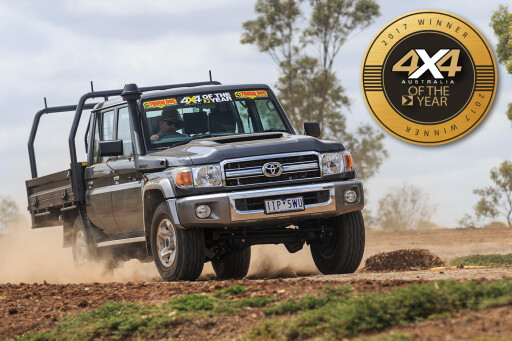
The LC79 won’t be for everyone, and it certainly doesn’t raise the bar in terms of technology, safety or refinement like, say, the Amarok does, but it’s still one of the most capable 4x4s on the market, with a fantastic TDV8 engine and vastly improved touring capability.
The ageing 70 Series Land Cruiser could have easily been killed off, but pressure from Australian mining companies and other commercial operators convinced Toyota there was life in the ‘old girl’ yet. While the Double Cab doesn’t benefit from all of the upgrades that see the Single Cab variant achieve a five-star ANCAP rating, it does receive several upgrades that not only improve the vehicle’s safety, but also its touring capability.
If you want a big, capable 4x4 that you can be confident will take you and your family to the most remote parts of Australia and get you home again, you can count on the Land Cruiser 79 to do the job.
MORE 4X4 OF THE YEAR
 HOME: 4X4 OF THE YEAR 2017
HOME: 4X4 OF THE YEAR 2017
The seven most interesting 4x4 vehicles of 2016 get together for a week to determine the 4x4 Of The Year.
 THE FINALISTS
THE FINALISTS
Meet the seven most interesting 4x4 vehicles of 2016 battling it out to be crowned 4x4 Of The Year.
 THE RESULTS
THE RESULTS
Only one of the seven best 4x4s from 2016 can be crowned 4x4 Of The Year 2017
 4X4 OF THE YEAR HOME
4X4 OF THE YEAR HOME
Finding Australia's Best 4x4s

COMMENTS